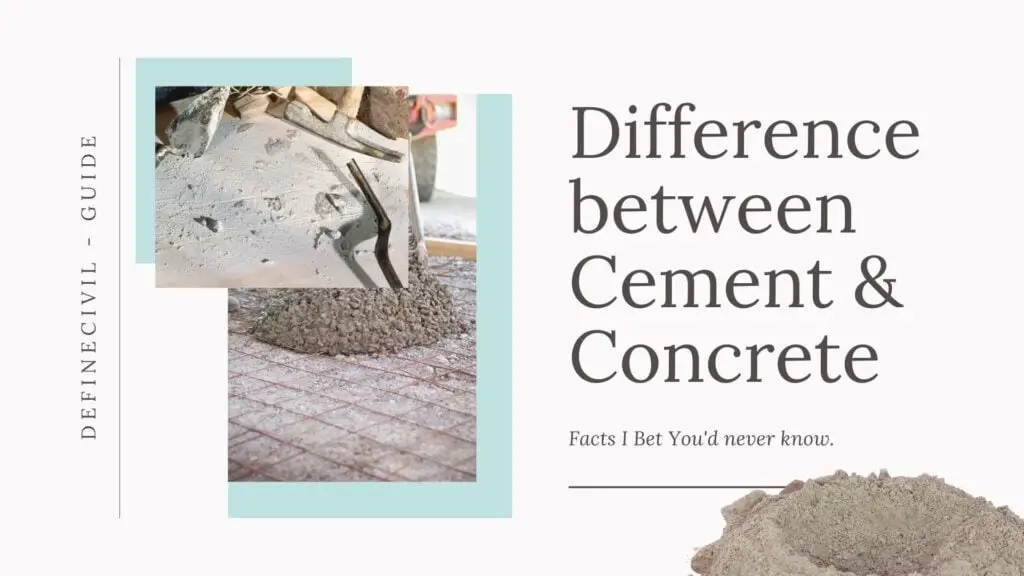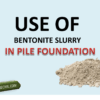As there’s a big difference between cement and concrete, you’re at times confused what to use. You want to fix an old stone wall or maybe a brick sidewalk, it’s easy right! Just go down to the Home Center pick up a bag of cement or is it concrete no wait maybe mortar.
Well, many people confuse cement, concrete, and mortar. But they’re actually very different building materials and they have very different uses.
When you’re a newbie in construction site, you are confused many times if you need cement or a concrete for filling that hole or void?
What is the difference between cement and concrete?
What is cement? What is concrete? How important is it in construction? These are just some of the questions that you may have when asking yourself. Understanding concrete and cement is essential to know what role each has in construction.
The words “cement” and “concrete” are used interchangeably, due to their perceived similarities. Both play important roles in construction and without them, buildings would undoubtedly fall apart. But they couldn’t be more different from each other.
So, what exactly is the difference between cement and concrete?
For understanding the main differences between cement and concrete in a structure you need to focus on areas like function, creation, and usage.
Concrete is basically a mixture of ground sand, aggregate, water, and cement.
Cement is also one type of binding material that binds the aggregate materials together (both coarse and fine).

What is cement?
Let’s start with cement.
Cement is a well-known binding agent used to make building materials stick to each other. Its one-of-a-kind construction material that’s versatile and unique. Its adhesive properties are the result of the calcium and silica-rich materials, such as limestone and clay.
Cement may be capable of binding things together; however, the biggest disadvantage to making use of it is that it’s extremely prone to cracking, especially when utilized on its own.
Cement is a fine powder that hardens when you add water.
There are many different types of cement but the most common is called Portland which is gray.
What is the purpose of cement? Well, cement can be defined as a hardening material derived from limestone, gypsum, and silica. It is mixtures of different ingredients that hardens and sets when react as a result of hydration reaction. . Cement is used in two forms – liquid and paste. Liquid cement paste is used for wet fix applications in the form of grout while plastic paste is used for dry fix applications like repair.
Also Read: Concrete Retarders – Disadvantages – Types – Uses – Price
What is mortar?
Mortar is a mixture of cement lime and sand and it’s often used to hold together different building materials like brick block or stone.
When wet mortar is much thicker than concrete and Masons use a trowel or a special tool called a joiner to work it into the joints. When it hardens mortar is actually softer than cement and that’s a good thing any wall is going to move over time and with a soft mortar.
It allows the wall to move just a little bit. Different types of mortar have different strengths. So make sure you get the right type for your job.
What is concrete?
That’s the part where we need concrete. So, what’s the concrete?
Concrete is a long-lasting building material that is often used in the construction industry. And perhaps the biggest reason why it always gets confused with cement is because it uses cement as one of its primary components. So, we can say cement is the part of the recipe that makes up concrete.
Cement is rarely used by itself but it’s the active ingredient in many other building mixes. Concrete is a mixture of Portland cement sand and coarse stone called aggregate. When wet concrete is thin and it’s poured into forms to create foundation walls footings steps even sidewalks.
When it hardens, concrete can sustain heavy structural loads.
More specifically, it makes use of Portland cement, which comes either as a dry powder or as a paste, referred to as mortar. The concrete gradually hardens before sticking to whatever it’s touching.
Here’s how we make concrete;
We mix stone, sand, water, and Portland cement with each other. How strong the concrete will be is hinged on the amount of water that is added to the mixture, the less water put in, the stronger the resulting concrete will be.
Water is a crucial ingredient in this mixture because of how it reacts with the cement, activating it, so it becomes the binding agent. This, when combined with aggregates, such as gravel and sand, form concrete.
Now, what makes concrete high-quality?
Concrete may be stronger if not a lot of water was added to the mixture; however, if an inadequate amount of water is added, then the resulting concrete ends up too dry, which means that it can’t be used in constructing a building. That’s the part where you need to know about workability.
More importantly, high-quality concrete must be resistant to freezing and thawing, as well as to deicing chemicals. To add to that, it also has to be watertight, durable, and resistant to wear.
In the simplest of terms, construction workers consider the following elements when mixing concrete: workability
- Strength
- Durability
- Density
- Appearance
All these criteria can be ascertained through a close examination of the texture and look of the concrete mixture.
Difference between cement and concrete
Now, when are cement and concrete used?
Concrete is much more durable than cement and is even capable of lasting hundreds of years. Because of this, its primary used in large construction projects, including building schools, bridges, and other similar structures.
Additionally, it’s also used for DIY projects, like creating new kitchen countertops and front walkways or landscape edging.
On the other hand, cement is used in smaller construction projects, or those that don’t need to be able to support hundreds of people, vehicles, and whatnot at the same time.
For instance, jobs like grouting and repairing cracked concrete all make use of cement.
Difference between Mortar and Concrete
Concrete mortar is a thick mixture of sand and cement whereas concrete is a mixture of sand cement and water but also chippings of stones and rocks. Mortar is less durable than concrete on the other hand concrete is much stronger as compared to the mortar because of its composing elements the water to cement ratio is higher in mortar and hence acts as perfect glue to bonding materials like bricks. Low water to cement ratio makes concrete and unfit bonding material mortar has to be replaced every 25 to 50 years hence not practical for use.
Concrete works intact for a really long time and hence finds application in several purposes. Mortar is used mostly as a bonding element for example glued together bricks. Whereas concrete is used for support such as beams walls and other building elements i.e. structural purposes.
Mortar is less strong thick mixture less durable as the latter on the other hand concrete is thinner stronger more durable. Mortar finds application as a bonding element while concrete finds application in structural and decorative purposes like beams fireplaces walls etc.
Signing off
Did you know cement and concrete were different or did you think they were simply two names for the same thing? Picking the right cement concrete or mortar can be tricky but once you get the right material the rest is easy you.
Let’s talk about it in the comment section down below.
Don’t forget to share the post with your friend. And remember, what’s learned here, leaves here.
Share something you learned about the difference between cement and concrete with a friend. See you later.



















